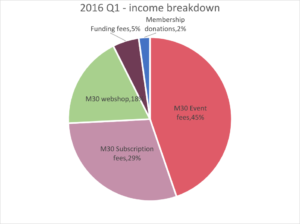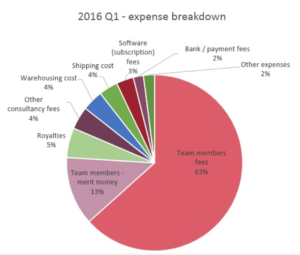by Jennifer Riggins
Editor’s Note: At the time of publication the parent company for Management 3.0 was called Happy Melly One. It’s now called Happy Melly Group. This article specifically speaks to an experiment we ran called Happy Melly. Happy Melly today has been absorbed by Management 3.0 as the ‘happiness arm’ of the company.
At Management 3.0 — in case you haven’t noticed — we take transparency seriously. After all, we experiment in happiness at work, the only difference is that instead of a scientist going through and testing everything and then publishing our results, we’re transparent from the get-go, over-sharing details of our ongoing experiments. During her first week of work, our newest member Sam sat in on an uncomfortable conversation where myself and a couple other colleagues were dealing with the stress over the lack of clarity of roles in our newest version of scaling. And then Sam wrote about it for the world to witness our awkwardness that was mostly resolved by open communication.
But the one thing we haven’t been transparent about is our money.
After all, our supporters are putting some money toward how our business works, and then our funders are sending a much more significant amount our way. Plus, one of those companies that continue to inspire us is Buffer, who have benefited from their “default to transparency“. We believe the modern business should work to take the edge of secrecy off of finances and become more transparent, but we feel an even greater responsibility because we’re taking your money.
Our financial transparency wasn’t for lack of trying, it was more for lack of hiring the right person. But we finally have! Next week, we will introduce you to our fabulous financial wizard that has been spending the first part of the year getting us back on track toward fiscal clarity. Now, finally, today we can share some of that with you.
How exactly does the company work?
It seems important to first explain the organization. Happy Melly One BV (Dutch for LLC) is the umbrella organization that 12 us work for, none of us full time. Jurgen Appelo owns the company. Happy Melly One BV also owns the Management 3.0 brand, which is five years old; Happy Melly, which was an experiment run by the company several years ago, has been charging memberships for a little over a year now. Happy Melly funders — like Collaboration Superpowers, Learning 3.0, and Lean Change Management — are also under the Happy Melly umbrella, but we do not gain any income from them, except their annual funders’ fee.
How does Happy Melly (the experimental project) make an income?
So where do we financially stand? A bit in the red. But let me explain with a Q1 2016 visualization.

As you can see above, Management 3.0 events make almost half our income, followed by the annual subscription fee that Management 3.0 facilitators pay. We also have the Management 3.0 webshop, which I’ll touch on later in the article. Management 3.0 courses and workshops have been going on for five years now.
We have nine Happy Melly funders making up five percent of our income, as well as 301 Happy Melly supporters to date, equating two percent more. Happy Melly has been charging for just over a year now.
What is Happy Melly spending money on?

This is probably the most important part for members of the Happy Melly business network to understand, in order to see where your money’s going.
As you can see, the 12 of us are Happy Melly’s biggest expense (and we rather like to hope we’re the most valuable one.) To follow Buffer’s suit on salary transparency, we make 600 euros per month, per percentage of commitment, from level one to five. As freelancers with other gigs, we make our own schedules, and no one, including Jurgen, works full-time on this project, leaving no one with a Level Five. A Level One commitment is someone that works the equivalent of a day a week with us. Most people have commitment levels of Two or Three, which means they invoice 1200 or 1800, respectively. Of course, who has what Bonusly points and commitment levels is also always transparently shared, on our trusty Google Drive.
Then, no matter what the commitment level, we each get 100 Merit Money points a month that we can give away as we want to our teammates. Each month Jurgen glances at the finances and decides what amount should be put away toward bonuses — lately it’s been 2,500 euros for dividing among the team. Each month, one of us rolls a die and if we *fingers crossed* roll a six, we get a pay out based on our percentage of peer recognition accumulated since the last lucky roll.
A final expense to note is the software licensing. As an experimental, completely remote team, we like collaboration tools, we really like them. We are heavy users of Trello, IDoneThis and Bonusly, which we use for our merit money, as well as other administrative tools like Xero accounting software. Our greatest software expense though is probably Slack, which we not only use for the majority of our team’s almost-email-free communication, but that’s where the Happy Melly business network resides, as well as all of the facilitators for the different Happy Melly brands, meaning that we have more than 600 people on Slack.
But what does it all mean?
We were just about break-even last quarter, not counting paying out Management 3.0 content licensing, which besides one facilitator and soon another, is Jurgen, who always says he would just put it back into the Melly project, so if we only include the content payout to the facilitator that created one of the popular Management 3.0 modules, we are in the red, but hopeful. Now, for that breakdown…
The Happy Melly side of the brand is not for profit (which is not to be confused with a non-profit.) Currently we’re hoping for the Happy Melly Business Network to eventually break even, but this isn’t a profit-seeking venture. We are not looking to purposely scale Happy Melly — we’d rather have a smaller engaged community dedicated to happiness at work than a loud cacophony. Although we do want to impact the future of work, so we’re working toward a balance.
On the other hand, the goal of Management 3.0 is definitely to make a profit (while also influencing the future of work). We are looking to bring Management 3.0 around the world, which has grown from 80 to 180 facilitators in just the last year, with the ability of events to be given in 88 countries. We’ve also seen another 62 percent increase in the events being held. We have a steady demand for new Management 3.0 licenses, which we expect to grow even faster when Jurgen kicks off his North American Managing for Happiness book tour later this month. Plus, we now offer Certificates of Practice, so even ends of the Earth we haven’t reached yet can get licensed. Management 3.0 is steadily growing and we predict it to continue.

